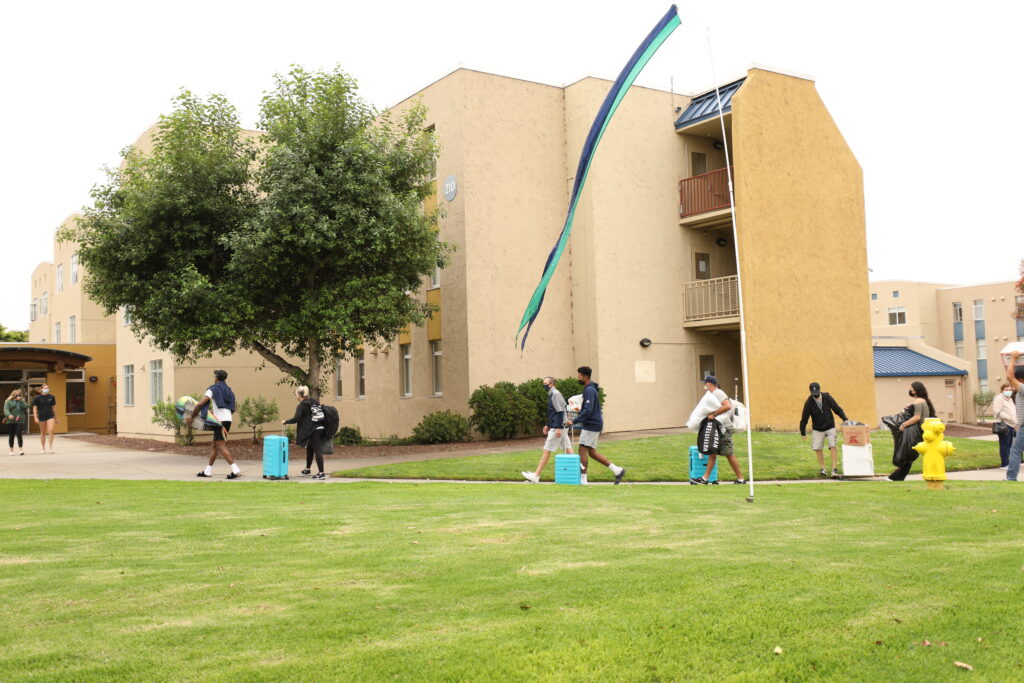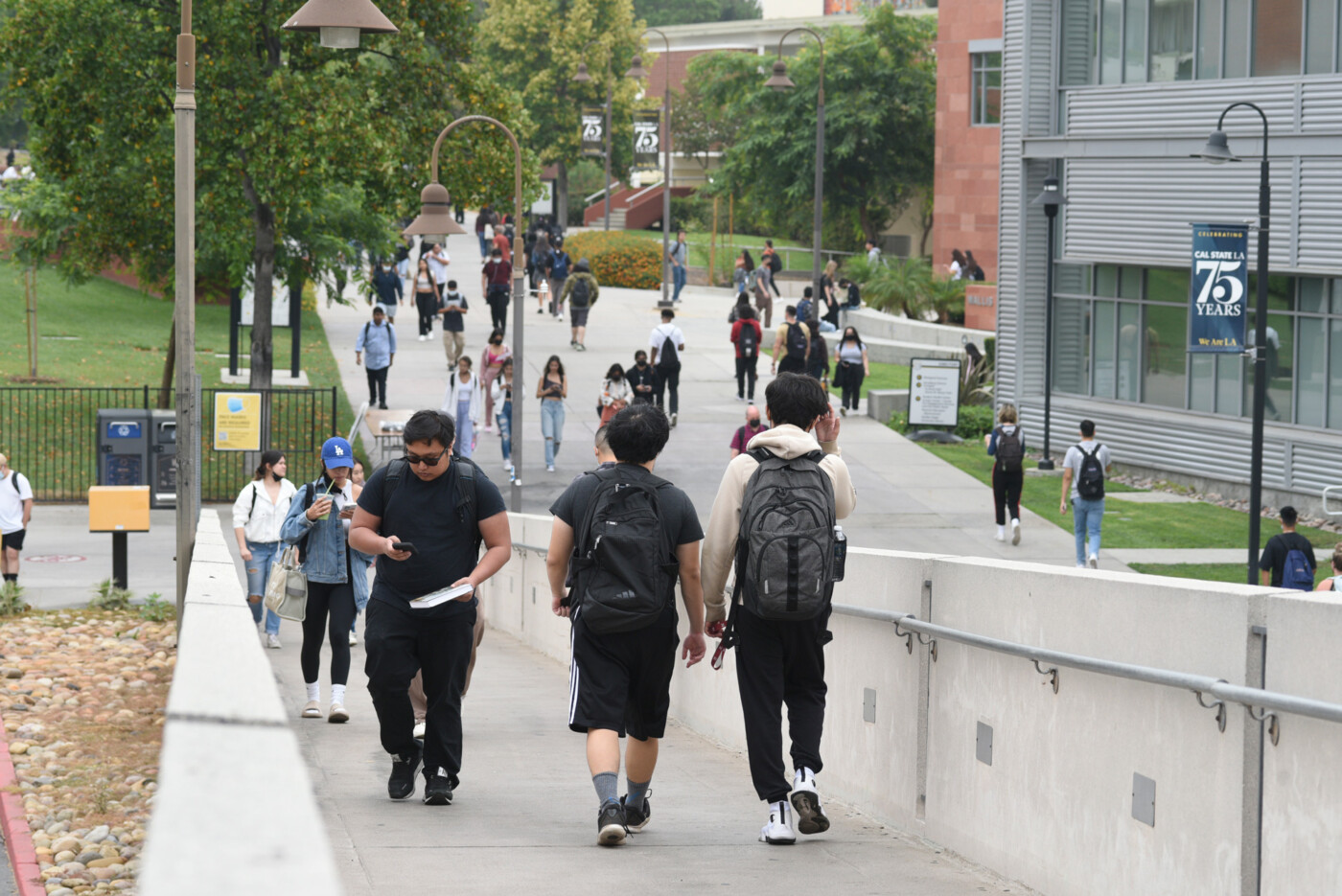Faculty, staff and students at four campuses in the Cal State system said they’re starting to feel the impact of belt-tightening in the early weeks of the 2024-25 school year, saying this fall has brought heavier workloads, larger class sizes and fewer course options.
University officials at select campuses acknowledged plans to reduce costs this school year. They said they’ve opened additional course sections where there’s demand and remain committed to supporting students so that they’re on track to graduate, even as they reel in budgets to match shrinking student enrollment on some campuses.
Cal State system officials said in July that the system could experience a $1 billion budget gap in the 2025-26 school year, a forecast driven by uncertain state funding, enrollment declines and rising costs. Trustees said they expect many campus leaders to reduce their overhead this year while also looking for creative ways to raise money going forward.
“It’s extremely difficult to get a hold of the classes that you want and/or need,” said Ashley Gregory, a Cal State LA student who works with the group Students for Quality Education through an internship program funded by the California Faculty Association. “It’s really disheartening.”
Cal State LA
California State University, Los Angeles, which has a $32.4 million deficit, is directing all divisions to cut their budgets by 12.4%.
The university is budgeting with the assumption that enrollment will come in 5.3% below the target for in-state full-time equivalent students it receives from the Cal State system, the school’s interim chief financial officer, Claudio Lindow, wrote in a Thursday email to the campus. Lindlow said there are signs that actual enrollment will reduce that gap.
Gregory said she’s already feeling the consequences of budget cuts on her major and minor fields — history, Pan-African studies and Latin American studies.
“I’m constantly having conversations with other students regarding, ‘Oh, this class is no longer available. This professor is no longer here,’” Gregory said.
A university dashboard showing enrollments by course lists fewer total courses in each of Gregory’s three departments this fall compared with the same time last year. In the history department, enrollment was down from more than 1,800 students in fall 2023 to fewer than 1,700 students this semester.
Juan Lamata, the faculty mentor to Students for Quality Education and a member of the California Faculty Association Los Angeles Executive Board, said he’s observed fewer electives in the English department, leaving a more narrow range of classes available to students.
“We’re changing what an English major means at Cal State LA, because now students will not have the opportunity to take classes in things they’re interested in or things that they don’t know they’re interested in,” he said. “We’re reducing what they can even be curious about.”
Cal State LA spokesperson Erik Frost Hollins could not confirm whether the number of courses offered by the university has declined but said course sections are down almost 7% compared with last year. The universityis not experiencing longer waitlists for fall courses as a result, according to Lindow’s email, but rather has lower waitlist numbers than in the past.
Cal State LA has gone from overenrolling students in excess of the target it receives from the Chancellor’s Office to experiencing an enrollment decline post-pandemic, President Berenecea Johnson Eanes wrote in a July letter to the campus.
Each condition strained the campus in different ways, Eanes wrote. When it was overenrolled, the university absorbed the costs of additional students without receiving additional state funding, she explained, which “had an adverse impact on the experience we can provide students.” But declining enrollment “feels like a budget reduction, because of the lost tuition, even though our funding per student is up,” she added.
“The greater risk lies in falling below enrollment targets, losing both tuition and state/system support,” Eames wrote. “This is why we need to focus on reversing enrollment declines and push to meet our enrollment target every year.”
Cal State LA headcount enrollment in fall 2023 was 24,673, up 6% compared with a decade ago, but below a pre-pandemic peak of 28,253.
Cal State East Bay
Another Cal State campus is reckoning with how to make sure it offers the courses students need while adjusting to a yearslong slide in enrollment.
Cal State East Bay enrollment has fallen almost 26% from its peak in 2016 to fall 2023. Explaining a decision to cut staff and administrator positions last year, officials said the university had not fully adjusted its budget to match those declines and also anticipated that its health insurance, utilities and benefits costs would rise, contributing to a structural deficit. President Cathy Sandeen, in a July message to the campus, said the school “must continue to explore all means to further reduce our expenses.”
A longtime faculty member said she worries that in trying to reduce overhead, the university is cutting instruction unnecessarily.Jennifer Eagan, a professor at the campus since 1999,said the university deferred dozens of eligible applicants to its Master of Public Administration degree program rather than expand the program to accommodate them this year.
“We have enrollments that we could be capturing, like classes we could be filling, cohorts of master’s programs that could be underway,” said Eagan, who served as the statewide president of the California Faculty Association from 2015 to 2019. “But the enrollments now are being artificially depressed, in my view.”
Cal State East Bay’s instruction expenses fell 11% from 2021-22 into 2022-23, according to the university’s two most-recent financial statements, tracking a year-over-year decline in enrollment.
Cal State East Bay spokesperson Kimberly Hawkins said in a statement that the university is “navigating a period of lower enrollment with a continued commitment to meeting students’ needs through strategic course offerings.” Hawkins said that, though there’s been a slight increase in waitlists to get into classes, the university has opened additional sections for certain courses. “Even as enrollment trends shift, our focus remains squarely on providing our students with timely offerings that fulfill their degree objectives,” she said.
Rin Anderson, a Cal State East Bay student interning for Students for Quality Education, said they see signs of tight budgets outside of academics, too. They said the university’s Student Equity and Success Center, which provides counseling for students from historically underrepresented communities, is underfunded and understaffed.
“The people that work for the university, who are in charge of these affinity programs, they’re overworked,” Anderson said. “They have so many different responsibilities and hats to wear.”

Cal State Monterey Bay
After a pandemic-era slump, Cal State Monterey Bay’s enrollment is showing signs of recovery.
The Central Coast campus saw a 15.6% increasein enrollment this semester compared with fall 2023 — an increase so big that the Monterey Herald reportedthe school is moving students into staff housing and modifying some dorms to fit an extra student in an effort to whittle down its waitlist for housing.
But Monterey Bay has also reduced its budget. A university official said in a statement the campus opted to trim costs at the beginning of this fiscal year to balance its budget and doesn’t anticipate any additional cuts later in 2024-25.
Meghan O’Donnell, a history lecturer at Cal State Monterey Bay and co-president of the school’s California Faculty Association chapter, said her department has lost seven faculty members; some departed through a voluntary separation program last spring, and others left because of frustration with lack of resources. She said the department hasn’t hired replacements.
“There’s just a lot of challenges losing that level of faculty, while also being told we have to do all of the same work, if not more, because now we actually have more students than we were anticipating having this fall,” she said.
O’Donnell is concerned that larger class sizes on her campus would make it harder for colleagues to incorporate experiential and one-on-one learning techniques into their courses — the kind of practices she said are especially effective for first generation students.
In a statement, CSUMB Provost Andrew Lawson said the university has a lower student-faculty ratio than other CSU campuses and remains “committed to providing strong mentorship and experiential learning opportunities to our students.” He said the Monterey Bay campus has added additional course sections to accommodate incoming students, including in general education courses for first-year students. The university’s colleges of science and business experienced the steepest enrollment increases.
Cal State Monterey Bay is also implementing what it calls an “incentive-based budget model,” which allocates funding to each of its colleges based partially on enrollment. Budget cuts last year impacted colleges with deeper enrollment declines more than those where enrollment was steady or dipped more modestly, Lawson said.
O’Donnell said that model is starving the budgets of departments like Spanish, ethnic studies and history.
Students “are being told that their desires don’t matter as much, basically, unless they’re in a major that’s actively growing based on market demand,” she said.

Cal Maritime
It’s not just faculty that are feeling the squeeze.
Cal Maritime, the smallest Cal State campus, has laid off 10 staff members, a university spokesperson confirmed. Sianna Brito, the president of the university’s chapter of the California State University Employees Union (CSUEU), said the Aug. 20 layoffs affected eight CSUEU members and two managers.
Declining enrollment and financial pressure have set Cal Maritime on a path to a possible merger with Cal Poly San Luis Obispo, a much larger campus 250 miles south of the current campus in Vallejo. The Cal State board of trustees opened discussions on the proposal to combine the two schools at its July meeting. It will weigh additional updates in September before voting on the plan in November.
Cal Maritime interim President Michael Dumont wrote in an Aug. 20 email to the campus that “enrollment challenges, state budget cuts, increased utility and insurance costs, and unfunded compensation costs” had left the university of 761 students with a combined $3.1 million deficit across its general operating and housing funds. He said the lack of funds “allowed us no other options” but to reduce staffing this year.
“I ask that each member of our community remember that we are being forced to do less with less, and we will need to exhibit grace and practice patience with one another as we continue assessing our operations and as we approach the integration recommendation decision,” he wrote. “We need to be clear eyed and realize that what we have been able to support or accommodate in the past may not be able to occur this year.”
Brito was among the staff who lost jobs. She said the layoff was unusually abrupt, blindsiding the managers to whom she reports and leaving no time to plan for colleagues to take over her responsibilities, which include the logistical and fiscal work behind the school’s faculty development and study abroad programs.
“We immediately had to turn in our business cards, our keys. We were locked out of our emails. We had to turn in laptops, and we were escorted off campus immediately upon being notified that we were laid off,” she said.
That was a shift from past layoffs, Brito said, in which departing employees continued working until their layoff date and were celebrated in campuswide emails. This time around, she said, Brito and her colleagues will be paid out until their official layoff date in October, but they ceased working the same day they were notified.
There could also be implications for students. Part of Brito’s job had been the fiscal processing that allows Cal Maritime students who aren’t studying for a Coast Guard license to study abroad.
“Now my job is parceled out to people who don’t have the institutional knowledge of the program,” she said. “So I personally feel like our students are not going to get the best experience with me not supporting that program.”
